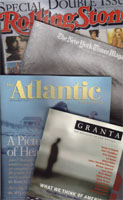|
|
Bill Di Nome | Trailer 5, Lot E | 962-7138 | dinomew@uncw.edu University of North Carolina Wilmington, Department of English Class Hours: 6:30–7:45 p.m. | Tuesday& Thursday @ MO 204 Office Hours: Tuesdays 2–3 p.m. & by appointment
English 311-001 Professional Magazine Writing Spring 2008
|
|
|
Course Descripton & Requirements Manuscript Requirements & Submitting Electronic Files Materials: |
Submission Components for Stories (S1–S4)
Story assignments must include the following six components, edited into a single document when possible. Not meeting the minimum criteria for length, sourcing or submission components renders a story unsatisfactory—equivalent to a grade of D. This may put an assignment in danger of failing, should additional shortcomings exist.
1. The story itself. Each story must meet the requirements stated in the publication’s guidelines. If a magazine does not accept feature articles longer than 1,500 words, do not pitch a 2000-word story. 2. Query or cover letter, addressed to a real editor at a real magazine. For S1 and S2, write a cover letter. For S3 and S4, write a query letter. Only choose publications for which your stories are of suitable length, subject and style. 3. A brief explanation: Why you chose the publication queried. Example: “Grit is 90% freelance written, open to new writers, geared to the same audience my article addresses (rural Baby Boomers), runs two features monthly, and pays 25¢ per word for features. I have been reading the magazine for years and understand its editorial stance. The magazine has not published a similar article since....” 4. Writer's guidelines from the publisher are needed for S3 and S4 ONLY. Writers' guidelines are frequently available online or by request. For guidelines online, simply provide the URL for this component. If a publication does not publish guidelines, it is up to you to examine several issues of the magazine and derive guidelines based on your examination. Writer's Market listings are not sufficient. 5. A sources list. Provide the full names of your sources, plus their phone numbers or e-mail addresses in case I have questions. List everyone you quote directly, paraphrase, allude to, or use on background. No need to list those you interviewed but could not use. 6. Checklist & Self-Assessment. Use this form to assess the quality of your own work and to check that you have packaged all the components.
For the grade weight of each component, see Grading & Grade Weights.
Identifying Assignments: When submitting stories electronically, kindly identify the file by your last name and assignment abbreviation. Examples:
File Management: Always, always back up your files by copying them to an external medium or remote server. (Backup tips here.) If you have problems with your computer or e-mail account, notify the Technology Assistance Center (ext. H-E-L-P) immediately. Failure to submit work on time due to computer problems is inexcusable. You are solely responsible for managing your materials.
Accuracy and Appearance: The physical appearance of submissions matters, so take pains to create attractive, professional typescripts and letters. Double check every fact, name and professional title. Use proper AP style, and also refer to the AP manual religiously whenever refering to facts and terminology commonly named in journalistic settings. Spellcheck and proofread manuscripts before submitting them.
Sources: The number of sources you use for a story is directly proportional to the article’s length and complexity. The assignment descriptions stipulate minimum numbers of sources for each story.
Maintain a healthy skepticism about what sources tell you. Independently corroborate the street address she gave you. If he says he’s a student at UNCW, look him up in the online directory and ask the office of the Dean of Students to confirm it. Use quotations and paraphrases liberally. Your notes and your tape recordings (taping interviews is recommended) must be available for me to review on demand. Maintain your files.
|
